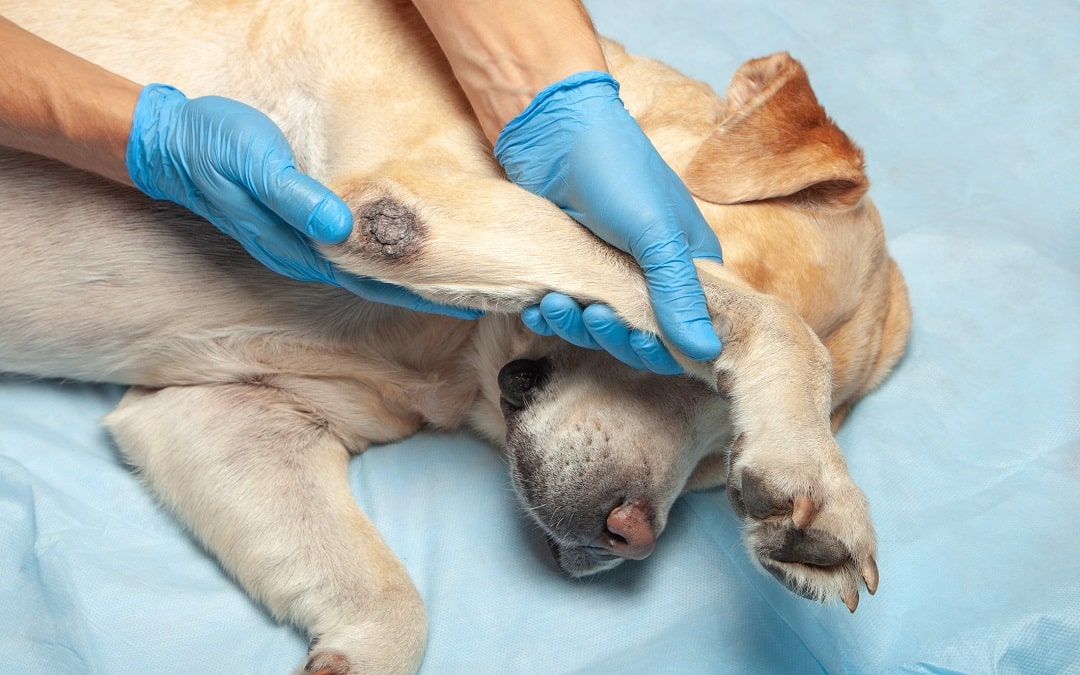Elbow dysplasia generally occurs in medium, large, or giant dog breeds. Dysplasia means abnormality of development, and this is precisely what occurs. The elbow is a complex joint, involving three bones which need to align correctly to prevent issues from occurring. Elbow dysplasia is a painful condition for dogs, which can show up from as young as 5 months. Mild elbow dysplasia may not be diagnosed till later in life after arthritis has developed in the elbow.
There are ways to prevent, manage and treat elbow dysplasia, so if you have any concerns over your pet’s health, contact your trusted vet.
What is Elbow Dysplasia?
Elbow dysplasia occurs when the three bones that make up the elbow joint do not grow together. If the bones don’t fit perfectly together, they cause pressures and strains around the elbow joint. Canine elbow dysplasia varies in severity, from very severe to mild. In mild cases, symptoms may not show till the dog is a few years old, whilst severe cases may show signs from a few months old.
Breeds Prone to Elbow Dysplasia
Certain breeds are more prone to elbow dysplasia. It is generally seen in medium, large, or giant size dogs, and breeds including; Labradors, Golden Retrievers, Rottweilers, German Shepherds, Bernese Mountain Dogs, Newfoundlands, and Bassett Hounds. If you are buying a breed of puppy that is prone to elbow dysplasia, ensure that the parents have been screened for elbow dysplasia.
The Kennel Club runs an elbow dysplasia screening scheme, which encourages breeders to only breed from dogs with a good score. If you are buying a non-KC registered puppy, be extremely careful.
Causes and Contributing Factors of Elbow Dysplasia
Whilst there are genetic factors at play in the development of elbow dysplasia, it can also be affected by how a puppy is raised, and the pressure placed upon his joints. Always follow the guidelines for exercising your puppy, especially with the larger breeds, which tend to be more susceptible to joint conditions.
Puppies should enjoy short, regular exercise sessions that help build strong bones. Over-walking young puppies, or letting them jump onto furniture, or run up and down stairs, can have a detrimental effect on their bone development. Carrying extra pounds places more strain on the joints, so be aware of the weight of your puppy and young dog. Improving their waistline can help with their joints.
Signs and Symptoms
As a good dog owner, you will notice changes in your dog’s behaviour. While elbow dysplasia can present as obvious forelimb lameness, sometimes it can be subtle, and if present in both elbows it can cause the dog to waddle, rather than limp. If your dog seems reluctant to exercise, this could indicate pain during exercise. Elbow dysplasia doesn’t necessarily present as a dog that is lame all the time. The key time to watch them walk is after they have exercised and rested, the elbow dysplasia lameness can show up clearly at this time.
If you aren’t sure, it is always better to ask your vet’s opinion. You could always take a video of your dog, in order to show your vet if the lameness is only present at certain times. You may notice that your dog’s feet splay outwards, this can be a symptom of elbow dysplasia, but can also be a breed trait in breeds that are prone to elbow dysplasia, such as the Bassett Hound. In extreme cases, the elbow may be puffy and swollen.
Diagnosis of Canine Elbow Dysplasia
Diagnosis of elbow dysplasia is usually carried out with an X-ray of the joint. The vet will listen to your description of the symptoms, he will examine the joint, look for muscle wastage, and manipulate the joint to feel for any restriction or pain. If the X-ray doesn’t show the elbow joint clearly, then a CT scan can be carried out to give a greater level of detail of the elbow joint. Your vet will then be able to examine the scan and offer a treatment plan for your dog.
Elbow Dysplasia Treatment
Treatment will vary depending on the severity of the symptoms. Mild cases of elbow dysplasia can be successfully managed with reduced exercise, a controlled diet, and anti-inflammatory painkillers for pain management. Hydrotherapy and physiotherapy can also help to improve your dog’s quality of life and help to manage the condition.
Where the presenting symptoms are more severe, it may be necessary to take the surgical process to repair and improve the joint function. Our experienced team will use arthroscopy (keyhole surgery) to operate on the joint. This involves placing a camera and small surgical instruments into the joint to view, and repair, the damage. Surgery can be very successful, as long as the dog receives good post-operative aftercare, and attention is paid to exercise and weight after the operation.
Post-Treatment Care
Post-op care is incredibly important with all types of surgery. With joint surgery, it is vital that you follow the advice of your vet. It will be very important to reduce exercise, and limit movement on the joint in the early days, and then follow a very gradual increase in exercise to ensure that the joint is given the best chance of healing successfully. You will be given a detailed post-operative plan, and here at Anrich Vets, we are always on hand if you have any concerns, or need any advice about the health of your dog.
Prevention
Some breeds are more prone to elbow dysplasia than others, but if you are choosing a breed that is known to suffer from this, be particularly vigilant about the health of the parents. Take care of your puppy and don’t over-exercise them, or overfeed them.
However, bear in mind that you can bring your puppy up correctly, and follow every piece of advice, and your dog could still get elbow dysplasia, so if it happens, and you have done everything that you should have, you aren’t to blame.
How Long Will a Dog Live with Elbow Dysplasia?
Elbow dysplasia is not a terminal disease, your dog can live with elbow dysplasia. Your responsibility as a good dog owner is to ensure that he lives a happy and fulfilling life. If this means he needs reduced exercise, or ongoing therapy to keep him healthy, then follow this advice. If he develops extensive elbow osteoarthritis in the elbow joint and the pain is too much for him to manage, then you may need to make the hard decision.
However, with good management and care, there is no reason why your dog can’t live a happy life, even with elbow dysplasia.
How Serious is Elbow Dysplasia?
Elbow dysplasia can vary in severity. When you come to the team at Anrich Vets, we will carry out a thorough examination of your dog. Our diagnosis will be able to show the severity of the joint disease, and our treatment plan will be designed to manage the condition to give your dog the best chance of a happy and pain-free life. Elbow dysplasia is a painful condition, and if left untreated could cause your dog serious problems. With good treatment and management, elbow dysplasia can be handled.
If you have any concerns or worries about your dog, or feel that he may be exhibiting symptoms of elbow pain, please book an appointment with our experienced vet team here at Anrich Vets, by calling us today on 01942 242001.

